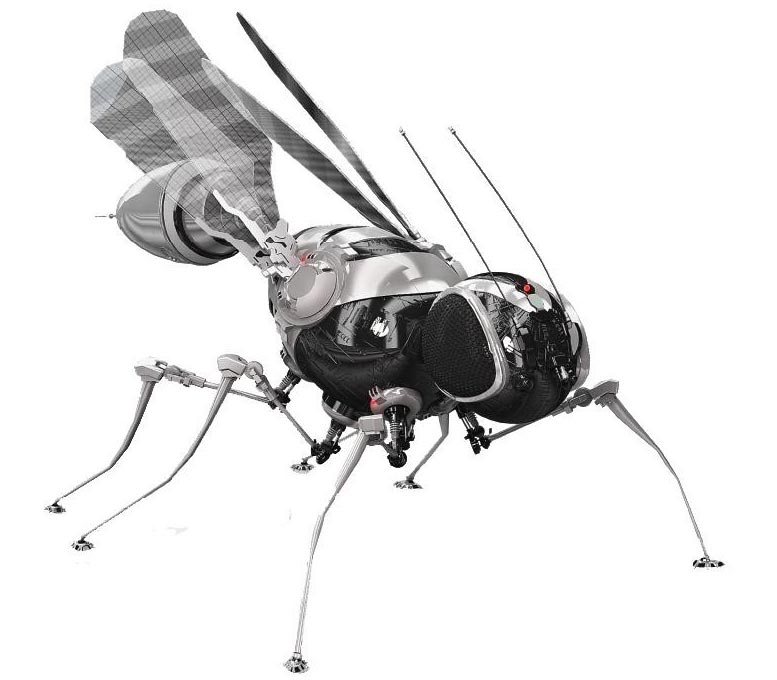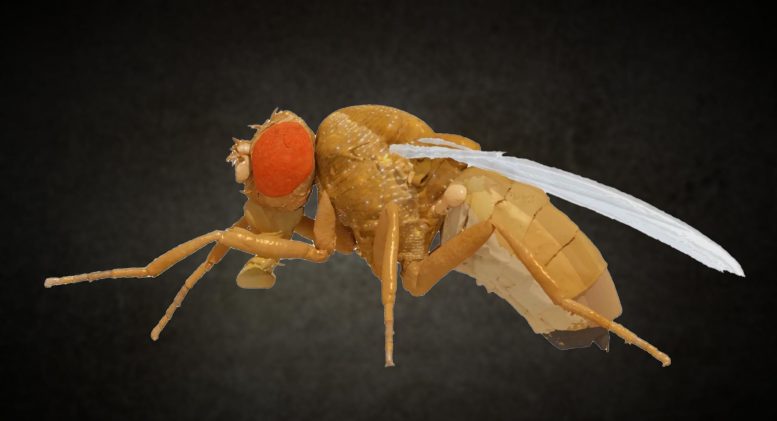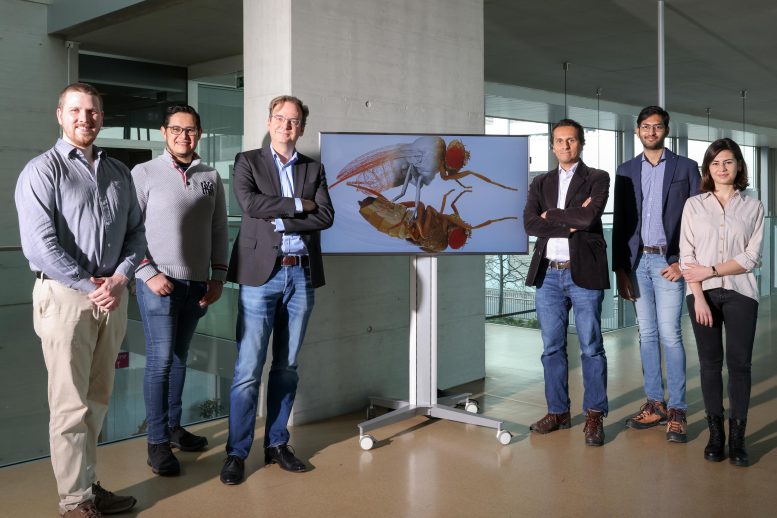
NeuroMechFly, the primary correct “digital twin” of the fly Drosophila melanogaster, affords a extremely worthwhile testbed for research that advance biomechanics and biorobotics. This might assist pave the way in which for fly-like robots, such because the one illustrated right here. Credit score: EPFL
A Digital Twin of Drosophila
“We used two varieties of knowledge to construct NeuroMechFly,” says Professor Pavan Ramdya on the College of Life Sciences at Ecole Polytechnique Fédérale de Lausanne (EPFL). “First, we took an actual fly and carried out a CT scan to construct a morphologically sensible biomechanical mannequin. The second supply of knowledge was the true limb actions of the fly, obtained utilizing pose estimation software program that we’ve developed within the final couple of years that enable us to exactly observe the actions of the animal.”
Ramdya’s group, working with the group of Professor Auke Ijspeert at EPFL’s Biorobotics Laboratory, is publishing a paper as we speak (Could 11, 2022) within the journal Nature Strategies showcasing the primary ever correct “digital twin” of the fly Drosophila melanogaster, dubbed “NeuroMechFly.”
Time flies
Drosophila is essentially the most generally used insect within the life sciences and a long-term focus of Ramdya’s personal analysis, who has been engaged on digitally monitoring and modeling this animal for years. In 2019, his group revealed DeepFly3D, a deep-learning based mostly motion-capture software program that makes use of a number of digital camera views to quantify the actions of Drosophila in three-dimensional house.
Persevering with with deep-learning, in 2021 Ramdya’s group revealed LiftPose3D, a way for reconstructing 3D animal poses from 2D photos taken from a single digital camera. These sorts of breakthroughs have supplied the exploding fields of neuroscience and animal-inspired robotics with instruments whose usefulness can't be overstated.

A digital mannequin of Drosophila melanogaster referred to as NeuroMechFly. Credit score: Pavan Ramdya (EPFL)
In some ways, NeuroMechFly represents a fruits of all these efforts. Constrained by morphological and kinematic information from these earlier research, the mannequin options unbiased computational components that simulate totally different components of the insect’s physique. This features a biomechanical exoskeleton with articulating physique components, akin to head, legs, wings, belly segments, proboscis, antennae, halteres (organs that assist the fly measure its personal orientation whereas flying), and neural community “controllers” with a motor output.
Why construct a digital twin of Drosophila?
“How do we all know after we’ve understood a system?” says Ramdya. “A technique is to have the ability to recreate it. We'd attempt to construct a robotic fly, but it surely’s a lot sooner and simpler to construct a simulated animal. So one of many main motivations behind this work is to begin constructing a mannequin that integrates what we all know in regards to the fly’s nervous system and biomechanics to check if it is sufficient to clarify its conduct.”
“Once we do experiments, we are sometimes motivated by hypotheses,” he provides. “Till now, we’ve relied upon instinct and logic to formulate hypotheses and predictions. However as neuroscience turns into more and more difficult, we rely extra on fashions that may convey collectively many intertwined parts, play them out, and predict what may occur in the event you made a tweak right here or there.”
The testbed
NeuroMechFly affords a extremely worthwhile testbed for research that advance biomechanics and biorobotics, however solely in as far as it precisely represents the true animal in a digital surroundings. Verifying this was one of many researchers’ predominant issues. “We carried out validation experiments which reveal that we are able to intently replicate the behaviors of the true animal,” says Ramdya.
The researchers first made 3D measurements of actual strolling and grooming flies. They then replayed these behaviors utilizing NeuroMechFly’s biomechanical exoskeleton inside a physics-based simulation surroundings.

Jonathan Arreguit, Victor Lobato Ríos, Auke Ijspeert, Pavan Ramdya, Shravan Tata Ramalingasetty, and Gizem Özdil. Credit score: Alain Herzog (EPFL)
As they present within the paper, the mannequin can truly predict varied motion parameters which can be in any other case unmeasured, such because the legs’ torques and get in touch with response forces with the bottom. Lastly, they had been ready to make use of NeuroMechFly’s full neuromechanical capabilities to find neural community and muscle parameters that enable the fly to “run” in methods which can be optimized for each pace and stability.
“These case research constructed our confidence within the mannequin,” says Ramdya. “However we're most considering when the simulation fails to duplicate animal conduct, stating methods to enhance the mannequin.” Thus, NeuroMechFly represents a strong testbed for constructing an understanding of how behaviors emerge from interactions between complicated neuromechanical techniques and their bodily environment.
A group effort
Ramdya stresses that NeuroMechFly has been and can proceed to be a group undertaking. As such, the software program is open supply and freely accessible for scientists to make use of and modify. “We constructed a software, not only for us, but in addition for others. Due to this fact, we made it open supply and modular, and supply pointers on find out how to use and modify it.”
“Increasingly, progress in science relies on a group effort,” he provides. It’s necessary for the group to make use of the mannequin and enhance it. However one of many issues NeuroMechFly already does is to boost the bar. Earlier than, as a result of fashions weren't very sensible, we didn’t ask how they might be immediately knowledgeable by information. Right here we’ve proven how you are able to do that; you may take this mannequin, replay behaviors, and infer significant info. So this, I feel, is an enormous step ahead.”
Reference: “NeuroMechFly, a neuromechanical mannequin of grownup Drosophila melanogaster” by Victor Lobato Ríos, Shravan Tata Ramalingasetty, Pembe Gizem Özdil, Jonathan Arreguit, Auke Jan Ijspeert and Pavan Ramdya, 11 Could 2022, Nature Strategies.
DOI: 10.1038/s41592-022-01466-7
0 Response to "NeuroMechFly: A Morphologically Realistic Biomechanical Model of a Fly"
Posting Komentar